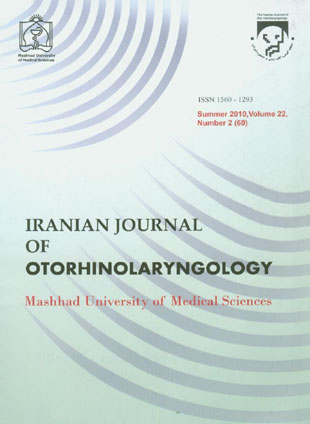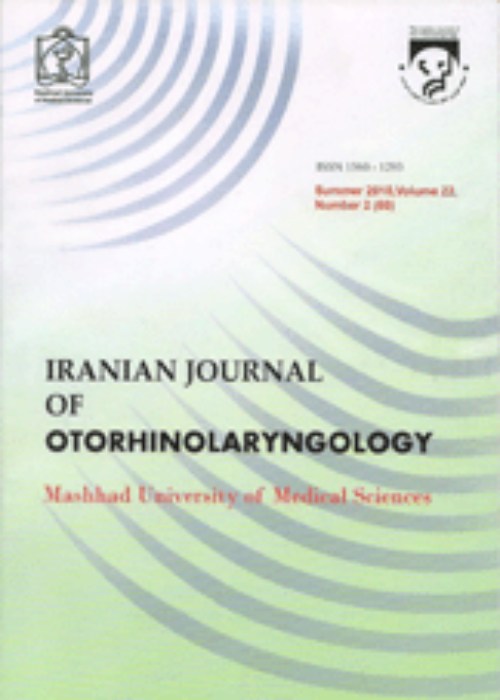فهرست مطالب

Iranian Journal of Otorhinolaryngology
Volume:22 Issue: 3, Jul-Aug 2010
- تاریخ انتشار: 1389/07/01
- تعداد عناوین: 8
-
-
Page 73Introduction
There is no single test as a gold standard for the diagnosis of allergic rhinitis (AR). This study was to assess the usefulness and validity of nasal smear as a quick, easy and inexpensive diagnostic method for diagnosis of allergic rhinitis.
Materials And MethodsThis study was conducted in a university hospital setting. Nasal smears were taken from 39 patients with a clinical history of nasal allergy and a positive skin prick test to at least one aeroallergen as well as 26 controls without any history and negative test. Biopsy specimens from the inferior turbinate as well as nasal smears of 19 cases including 9 patients and 10 controls with the same criteria were taken. Nasal smears and biopsy slides were stained with Giemsa and Hematoxilin-Eosin and were examined blindly by two separate pathologists.
ResultsFifty one percents of the patients and 11.5% of the controls showed eosinophilia in their nasal smear (≥10% eosinophils, P=0.001). The sensitivity of nasal eosinophil count as a diagnostic test for AR was 51.3% with a specificity of 88.5%, a positive predictive value of 87% and a negative predictive value of 54%. Eosinophilia in nasal biopsies was found in 44% and 30% of allergic patients and controls respectively. There was no significant correlation between symptoms or positive skin tests with either smear eosinophilia or tissue eosinophilia.
ConclusionEvaluation of eosinophils in nasal smear is an insensitive but fairly specific test for the diagnosis of allergic rhinitis. It seems that the nasal secretions and nasal tissue represent two distinct cellular compartments.
-
Page 79IntroductionHypertrophied tonsils and adenoids may cause upper airway obstruction and cardio-pulmonary complications due to pulmonary arterial hypertension. The aim of this study was to determine the correlation between mean pulmonary arterial pressure (mPAP) and selected adenotonsilar hypertrophy indexes.Materials And MethodsThirty two patients with upper-airway obstruction resulting from hypertrophied tonsils and adenoids were included in our study. Mean pulmonary arterial pressure was measured by a non-invasive method using color doppler echocardiography. Upper airway obstruction was evaluated by clinical OSA (obstructive sleep apnea) scoring and also adenoidal-nasopharyngeal (A/N) ratio in the lateral neck radiography.ResultsFifty percent of the patients with a normal OSA score, 20% of those with a suspected OSA score and also 50% of cases with OSA had pulmonary hypertension (mPAP>20mmHg) which was not statistically significant (P= 0.198). Mean Adenoidal-nasopharyngeal ratio in patients with a normal mPAP (mPAP ≤ 20 mmHg) was 0.61±0.048 and it was 0.75±0.09 in those with pulmonary hypertension; the difference was statistically significant (P=0.016).ConclusionIt seems that A/N ratio could be used as a predicting factor for increased mPAP in children with upper airway obstruction and a pediatric cardiologist consultation may be necessary before some surgical interventions.
-
Page 83Introduction
Salivary gland tumors are relatively rare and constitute 3-4% of all head and neck neoplasms. The majority (70%) of salivary gland tumors arise in the parotid gland. Recommended treatment for a parotid mass is surgical excision with a surrounding cuff of normal tissue to prevent recurrence.
Materials And MethodsThis is a retrospective study of 300 patients who were operated by a single surgeon for parotidectomy over a 20-year period in Ghaem Hospital, Mashhad, Iran. The patients'' age, sex, operation findings, pathology report and type of surgery (parotidectomy or mastoidectomy) were analyzed.
ResultsIn 25 cases we had to find the nerve in a retrograde fashion by finding the distal branches and dissecting backwards to reach the mass, whereas in 275 patients the trunk of the facial nerve was approached in a conventional antegrade fashion. Twelve cases needed some sort of repair on the nerve due to a trauma in the surgical field, either grafting or anastomosis was done. Interestingly mastoidectomy was required in 5 of our cases. The aim of these mastoidectomies was to eradicate the malignancy in cases where a perineural invasion was present. It also gave us a chance to find a normal proximal nerve ending in order to perform a safe nerve reconstruction (grafting or anastomosis).
ConclusionMastoidectomy and facial nerve anastomosis may be required in parotid surgery
-
Page 87IntroductionIn spite of the fact that acute otitis media is a systemic and symptomatic disease with sever otalgia, otitis media with effusion (OME) is an asymptomatic and silent disease. OME is the most common cause of conductive hearing loss in children and has adverse effects on speech development and cognitive skills.Materials And MethodsThis cross-sectional study was designed to determine the prevalence of OME in 1001 children, 3-6 years old in different kindergartens of Kerman. The subjects were evaluated by multi-staged randomized sampling. They were examined by otoscopy and pneumatic otoscopy, then suspicious cases were referred to Kerman Shafa University Hospital for tympanometry and acoustic reflex evaluation to confirm the diagnosis. The collected data were analyzed by SPSS software.ResultsAmong 1001 children under study, 57 subjects (5.7%) were diagnosed with OME, more than 50% of which were asymptomatic. Periodic otalgia and turning up television volume were the most common symptoms.ConclusionRegarding the improved knowledge on diagnosis and treatment of OME especially in younger children, hearing problems or cognitive and linguistic skills retardation may be avoided by promoting general information.
-
Page 93IntroductionCerumen is known as ear wax, produced regularly by cerumen and lipid secretary glands. Regarding the effect of Mazandaran province''s humid weather on the prevalence of pathogenic microorganisms, this study was performed to determine the bacterial flora of the ear in patients with acute otitis externa and its comparison with healthy subjects.Materials And MethodsIn this case-control study, cerumen was collected and cultured from 40 patients with clinically diagnosed acute otitis externa and 80 healthy controls. The data were finally analyzed using SPSS.ResultsIn the study group, Staphylococcus aureus (20.8%), Bacillus (18.9%) and Pseudomonas (11.3%) and in the control group Staphylococcus epidermidis (38.7%) and Diphtheroid (22.4%) were the most common bacteria, respectively.ConclusionThe isolated bacteria from cerumen of healthy subjects were totally different in comparison to those of acute otitis externa patients.
-
Page 97IntroductionThe outbreak of antibiotics and the improvement in dental hygiene have made the occurrence of deep neck infections less frequent than in the past. Nevertheless, the complications of these infections are often life threatening. The purpose of this study was to review the clinical findings in deep neck infections and identifying predisposing factors of these complications.Materials And MethodsIn this study, 147 patients with deep neck infections were studied in Imam Khomeini Hospital, Ahvaz, from 1997 to 2009. During the treatment, 24 cases of life threatening complications took place. Linear and logistic regressions and chi-square analysis were used to determine the association of the complications of deep neck infections with clinical parameters and longer hospitalization.ResultsAnalysis showed that patients with older age, patients with involvement of more than two spaces, involvement of cervical spaces, lymphadenitis, septic sore throat, congenital cyst as a source of abscess, odynophagia, dysphagia are those who require longer hospitalization (P<0.05). Complications are more likely to take place in patients with involvement of more than two spaces, involvement of cervical spaces, septic sore throat and odynophagia. (P<0.05).ConclusionPatients with involvement of more than two spaces or and with on underlying diseaseareathigh-risk of deep neck infection complications and should be monitored more closely during hospitalization.
-
Page 103Introduction
Thyroglossal duct cysts are one of the most common congenital pathologic findings in children's cervical area. This type of cyst can be located anywhere between the base of the tongue and the sternal manubrium.
CaseReportWe report the case of a patient with a double thyroglossal cyst, located inferior to the hyoid bone. The 2 cysts were connected by a common permeable tract, which confirms that an evolution failure of the embryonic remnants of the thyroglossal duct has been responsible for the development of such a cyst. Our case is the second case of double thyroglossal duct cysts and the first of double cysts located in the neck outsidethe thyroid gland.
-
Page 107IntroductionDegenerative changes of the cervical spine are more common in elderly, but anterior cervical osteophytes that cause problems in swallowing is rare. The most common cause of this problem is DISH disease (diffuse idiopathic skeletal hyperostosis). Trauma is also suggested as a potential cause in osteophyte formation.Case Report:We report a rare case of anterior cervical osteophyte with problems in swallowing that was caused by cervical spine trauma in during a car accident 4 years ago, treated with a cervical collar. Dysphagia was the initial symptom of the disease. Barium swallowing showed a large cervical osteophyte at the C3-C4 level with compression effect on the esophagus. X-ray, CT scan and MRI of the cervical spine confirmed the osteophyte and its correlation with the esophagus. Endoscopic study of esophagus and stomach also ruled out other disorders. Surgical osteophytectomy was performed.ConclusionUp to now, only two cases of post-traumatic anterior cervical osteophyte have been cited in the literature. In this report, we introduce an unusual case of dysphagia caused by cervical spine trauma.


